The Bulldozer Review: AMD FX-8150 Tested
by Anand Lal Shimpi on October 12, 2011 1:27 AM ESTPower Management and Real Turbo Core
Like Llano, Bulldozer incorporates significant clock and power gating throughout its design. Power gating allows individual idle cores to be almost completely powered down, opening up headroom for active cores to be throttled up above and beyond their base operating frequency. Intel's calls this dynamic clock speed adjustment Turbo Boost, while AMD refers to it as Turbo Core.
The Phenom II X6 featured a rudimentary version of Turbo Core without any power gating. As a result, Turbo Core was hardly active in those processors and when it was on, it didn't stay active for very long at all.
Bulldozer's Turbo Core is far more robust. While it still uses Llano's digital estimation method of determining power consumption (e.g. the CPU knows ALU operation x consumes y-watts of power), the results should be far more tangible than what we've seen from any high-end AMD processor in the past.
Turbo Core's granularity hasn't changed with the move to Bulldozer however. If half (or fewer) of the processor cores are active, max turbo is allowed. If any more cores are active, a lower turbo frequency can be selected. Those are the only two frequencies available above the base frequency.
AMD doesn't currently have a Turbo Core monitoring utility so we turned to Core Temp to record CPU frequency while running various workloads to measure the impact of Turbo Core on Bulldozer compared to Phenom II X6 and Sandy Bridge.
First let's pick a heavily threaded workload: our x264 HD benchmark. Each run of our x264 test is composed of two passes: a lightly threaded first pass that analyzes the video, and a heavily threaded second pass that performs the actual encode. Our test runs four times before outputting a result. I measured the frequency of Core 0 over the duration of the test.
Let's start with the Phenom II X6 1100T. By default the 1100T should run at 3.3GHz, but with half or fewer cores enabled it can turbo up to 3.7GHz. If Turbo Core is able to work, I'd expect to see some jumps up to 3.7GHz during the lightly threaded passes of our x264 test:
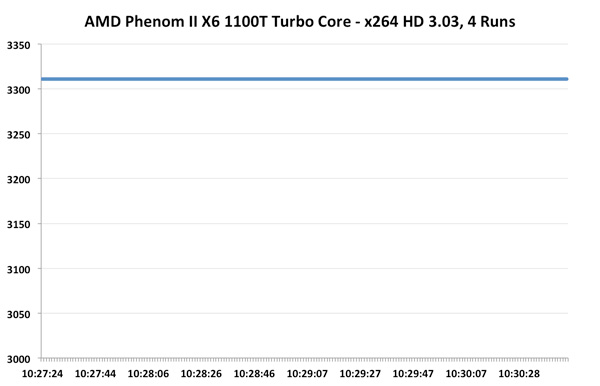
Unfortunately we see nothing of the sort. Turbo Core is pretty much non-functional on the Phenom II X6, at least running this workload. Average clock speed is a meager 3.31GHz, just barely above stock and likely only due to ASUS being aggressive with its clocking.
Now let's look at the FX-8150 with Turbo Core. The base clock here is 3.6GHz, max turbo is 4.2GHz and the intermediate turbo is 3.9GHz:
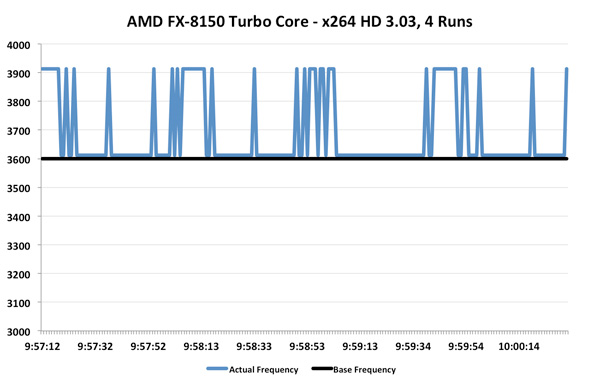
Ah that's more like it. While the average is only 3.69GHz (+2.5% over stock), we're actually seeing some movement here. This workload in particular is hard on any processor as you'll see from Intel's 2500K below:
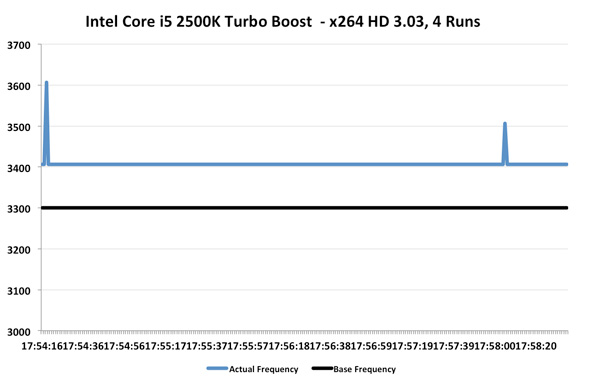
The 2500K runs at 3.3GHz by default, but thanks to turbo it averages 3.41GHz for the duration of this test. We even see a couple of jumps to 3.5 and 3.6GHz. Intel's turbo is a bit more consistent than AMD's, but average clock increase is quite similar at 3%.
Now let's look at the best case scenario for turbo: a heavy single threaded application. A single demanding application, even for a brief period of time, is really where these turbo modes can truly shine. Turbo helps launch applications quicker, make windows appear faster and make an easy time of churning through bursty workloads.
We turn to our usual favorite Cinebench 11.5, as it has an excellent single-threaded benchmark built in. Once again we start with the Phenom II X6 1100T:
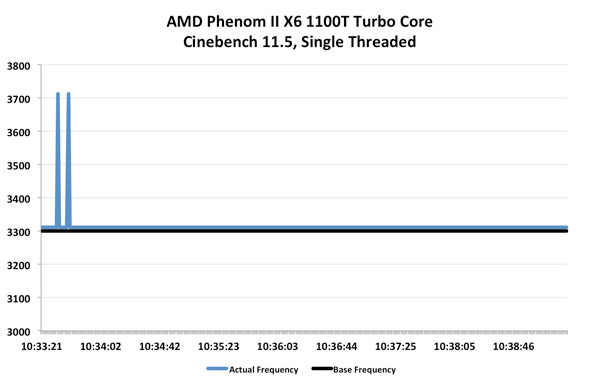
Turbo Core actually works on the Phenom II X6, albeit for a very short duration. We see a couple of blips up to 3.7GHz but the rest of the time the chip remains at 3.3GHz. Average clock speed is once again, 3.31GHz.
Bulldozer does far better:

Here we see blips up to 4.2GHz and pretty consistent performance at 3.9GHz, exactly what you'd expect. Average clock speed is 3.93GHz, a full 9% above the 3.6GHz base clock of the FX-8150.

Intel's turbo fluctuates much more frequently here, moving between 3.4GHz and 3.6GHz as it runs into TDP limits. The average clock speed remains at 3.5GHz, or a 6% increase over the base. For the first time ever, AMD actually does a better job at scaling frequency via turbo than Intel. While I would like to see more granular turbo options, it's clear that Turbo Core is a real feature in Bulldozer and not the half-hearted attempt we got with Phenom II X6. I measured the performance gains due to Turbo Core across a number of our benchmarks:

Average performance increased by just under 5% across our tests. It's nothing earth shattering, but it's a start. Don't forget how unassuming the first implementations of Turbo Boost were on Intel architectures. I do hope with future generations we may see even more significant gains from Turbo Core on Bulldozer derivatives.
Independent Clock Frequencies
When AMD introduced the original Phenom processor it promised more energy efficient execution by being able to clock each core independently. You could have a heavy workload running on Core 0 at 2.6GHz, while Core 3 ran a lighter thread at 1.6GHz. In practice, we felt Phenom's asynchronous clocking was a burden as the CPU/OS scheduler combination would sometimes take too long to ramp up a core to a higher frequency when needed. The result, at least back then, was that you'd get significantly lower performance in these workloads that shuffled threads from one core to the next. The problem was so bad that AMD abandoned asynchronous clocking altogether in Phenom II.
The feature is back in Bulldozer, and this time AMD believes it will be problem free. The first major change is with Windows 7, core parking should keep some threads from haphazardly dancing around all available cores. The second change is that Bulldozer can ramp frequencies up and down much quicker than the original Phenom ever could. Chalk that up to a side benefit of Turbo Core being a major part of the architecture this time around.
Asynchronous clocking in Bulldozer hasn't proven to be a burden in any of our tests thus far, however I'm reluctant to embrace it as an advantage just yet. At least not until we've had some more experience with the feature under our belts.


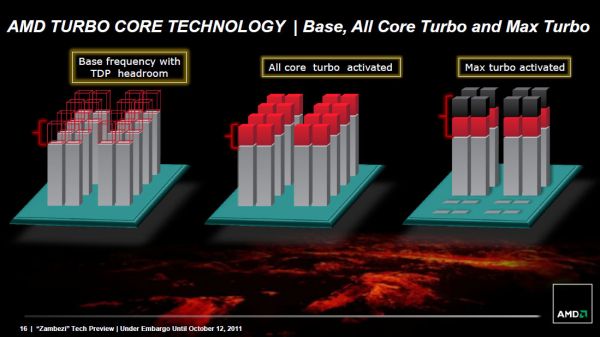








430 Comments
View All Comments
Mishera - Monday, October 17, 2011 - link
Good points TekDemon. But I'll add that from what I understand, the GPU might be capable of processing huge amounts of graphic information, but might have to wait for the CPU to process certain information before it's able to continue, hence some games going only so high in graphic tests no matter what kind of GPU is put in.Like he said, buying a good CPU will last longer than spending that money on a really good GPU. I personally try to build a balanced system since by the time I upgrade it's a pretty big jump on all ends.
Snorkels - Wednesday, October 12, 2011 - link
This and other benchmark tests are BOGUS. You are comparing apples to oranges. LiarMarks..This test shows non-optimized code for AMD vs optimized code for the Intel CPU.
It does not show the actual performance of the Bulldozer CPU.
Most software companies compile their software using Intels compiler, which creates crappy and unefficient codepaths for AMD processors.
Compile with Open64 compiler and you get a totally different result.
actionjksn - Wednesday, October 12, 2011 - link
@Snorkels If most software company's are using an Intel compiler, why would you want an AMD processor that can't utilize it properly.g101 - Wednesday, October 12, 2011 - link
Well, I'm happy that gamer children cannot understand the point of this architecture. You obviously have no concept of the architectural advantages, since it's not designed for game-playing children or completely unoptimized synthetic benchmarks.Bulldozer optimized and future-proofed for professional software, rather than entertainment software for children.
AssBall - Wednesday, October 12, 2011 - link
"obviously have no concept of the architectural advantages"Enlighten us then, oh wise one.
guyjones - Sunday, October 16, 2011 - link
Who exactly is the child here? Your infantile comment conveniently ignores the fact that AMD has made gigantic marketing pushes that are clearly directed at the gamer community, not to mention gaming-related sponsorship activities and marketing tie-ins. So, on the contrary, the company has made very visible and consciously-directed efforts to appeal to gamers with its products. It is totally unreasonable to now posit that BD is not directed at least in part toward that market segment.Will Robinson - Wednesday, October 12, 2011 - link
FailDozer....pretty limp performance numbers.Intel still rules.
etrigan420 - Wednesday, October 12, 2011 - link
What an unfortunate series of events...maybe my e8400 will hold out a little longer...Malih - Wednesday, October 12, 2011 - link
before reading (and i've read all other review sites -and disappointed at AMD-, just dying to see your view on the matter) thanks for the review as alwaysxorbit - Wednesday, October 12, 2011 - link
You are not measuring "branch prediction" performance. You are measuring misspeculation penalty (due to longer pipeline or other reasons). Nothing can "predict" random data-dependent branches.